So what drove the financial crisis? How did the Housing Bubble, the SubPrime Mortgages, the trading in Synthetic Derivatives all come together? Which were the chickens? Which were the eggs? Was it a plan, an attitude, or maybe just a perfect storm? One thing for sure, Alan Greenspan was a key player:
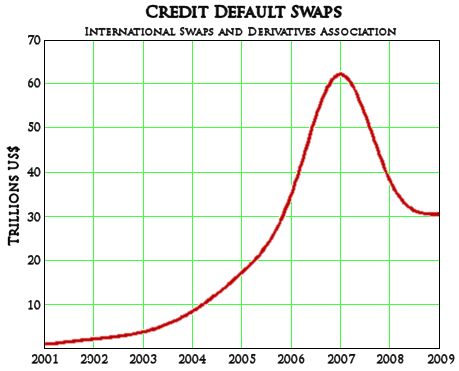 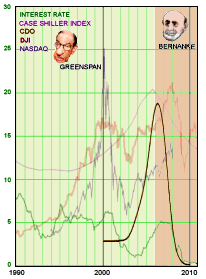 The thing I found most remarkable is the speed with which the derivative markets grew. Wendy Gramm had approved trading in derivatives originally in 1992 as she left the CFTC. The thing that got me on this particular kick was [of course] Alan Greenspan’s participation in the establishment of the whole derivative trading scene. In 1996, he vigorously opposed Brooksley Born’s attempt to regulate derivatives, getting Congress to forbid her to keep trying. She resigned in 1999. And the thing that essentially "legalized" derivative trading was the Commodity Futures Modernization Act of 2000 introduced by Phil Gramm and signed by President Clinton in his last month in the White House. Greenspan continued to be the champion for derivatives in Washington, after Phil Gramm retired. For example, there is this quote from his testimony in the Senate Banking Committee in 2003: The thing I found most remarkable is the speed with which the derivative markets grew. Wendy Gramm had approved trading in derivatives originally in 1992 as she left the CFTC. The thing that got me on this particular kick was [of course] Alan Greenspan’s participation in the establishment of the whole derivative trading scene. In 1996, he vigorously opposed Brooksley Born’s attempt to regulate derivatives, getting Congress to forbid her to keep trying. She resigned in 1999. And the thing that essentially "legalized" derivative trading was the Commodity Futures Modernization Act of 2000 introduced by Phil Gramm and signed by President Clinton in his last month in the White House. Greenspan continued to be the champion for derivatives in Washington, after Phil Gramm retired. For example, there is this quote from his testimony in the Senate Banking Committee in 2003: “What we have found over the years in the marketplace is that derivatives have been an extraordinarily useful vehicle to transfer risk from those who shouldn’t be taking it to those who are willing to and are capable of doing so,” Mr. Greenspan told the Senate Banking Committee in 2003. “We think it would be a mistake” to more deeply regulate the contracts, he added.
Alan Greenspan [2003]
One has to wonder what he is talking about. I’ve raved on about his use of "we," but there’s more. Derivatives had only been around since 2001, and yet he’s saying "we have found over the years in the marketplace…" as if he’s speaking from some vast experience. He would have been closer to the truth to say, "we have found over the last year in the marketplace." And from the graphs, derivatives [CDO’s and CDS’s] were still in their infancy at the time he gave his testimony. Then in March 2004, in a brisk discussion on the evidence of a "housing bubble" in a meeting at the Federal Reserve, Greenspan said:
"We run the risk, by laying out the pros and cons of a particular argument, of inducing people to join in on the debate, and in this regard it is possible to lose control of a process that only we fully understand," Greenspan said, according to the transcripts of a March 2004 meeting.
Alan Greenspan [March 2004]
If you read through the transcript of that meeting, you’ll wonder what he means by "a process that only we fully understand." It’s a bit hard to fathom what, if anything, they fully understood. They were a year and a half from the housing bubble bursting, and here’s what they released publicly:
"Reports from some contacts suggested that speculative forces might be boosting housing demand in some parts of the country, with concomitant effects on prices, suggesting the possibility that house prices might be moving into the high end of the range that could be consistent with fundamentals," reads the minutes, which were released to the public several weeks after the meeting.
And then in October 2004 Greenspan commented:
"While local economies may experience significant speculative price imbalances, a national severe price distortion seems most unlikely."
Alan Greenspan [October 2004]
|
 But it took more than just Alan Greenspan to create the environment for this financial crisis. Two star players in this story were former Senator Phil Gramm and his wife Wendy, former Chair of the CFTC and Enron Board member. Each in their own way played a special role in staging the long march that led us to the edge of the cliff:
But it took more than just Alan Greenspan to create the environment for this financial crisis. Two star players in this story were former Senator Phil Gramm and his wife Wendy, former Chair of the CFTC and Enron Board member. Each in their own way played a special role in staging the long march that led us to the edge of the cliff:
|
Phil Gramm went to Congress from Texas as a Democrat, but co-sponsored the Gramm-Latta Budget that implemented Reagan’s economic agenda. By 1982, he became a Republican and was elected to the Senate in 1984 where he served on the Budget and Banking Committees. He retired in 2003.
In the Senate, he was a workhorse for Reagan’s Budget cuts, cosponsoring the Gramm-Rudman-Hollings Act, the tool for across the board budget cuts used by the Reagan Administration. Meanwhile, his wife Wendy, also a PhD economist and champion for deregulation of the energy industry was appointed to the Office of Management and Budget‘s Office of Information and Regulatory Affairs and in 1988 became Chairman of the Commodity Futures Trading Commission [CTFC]. During her tenure, she began to allow derivative trading, previously prohibited, and exempted derivatives from regulation. At the end of her term, she moved on to the Board of Enron, on the audit committee [of all things!]. Then husband Phil took charge. In 1999, he cosponsored the Gramm-Leach-Bliley Act that repealed the Glass-Steagall Act of 1933 that had enforced separation of Commercial Banks, Investment Banks, and Insurance Companies. He followed that with the Commodity Futures Modernization Act of 2000 that opened up OTC unregulated derivative trading. The Gramms were the dynamic duo that gave us deregulation, Enron, and Derivatives. Without the two of them, where would we be?
|
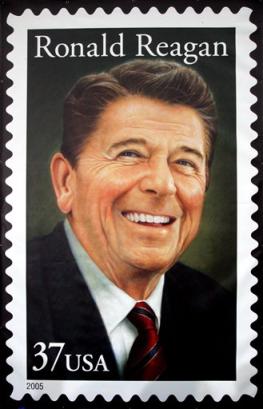 But none of this would have been possible without President Ronald Reagan. He appointed Alan Greenspan as Chairman of the Federal Reserve in 1987, Wendy Gramm as Chairman of the Commodity Futures Trading Commission in 1988, completely changed our income tax structure, tripled the National Debt, and ushered in the economic plan we now call Reaganomics that laid the base for our current financial tangle. If we were to pick the single most powerful force in this story, it’s Ronald Reagan – hands down [no need for reminders here – we all know the story].
But none of this would have been possible without President Ronald Reagan. He appointed Alan Greenspan as Chairman of the Federal Reserve in 1987, Wendy Gramm as Chairman of the Commodity Futures Trading Commission in 1988, completely changed our income tax structure, tripled the National Debt, and ushered in the economic plan we now call Reaganomics that laid the base for our current financial tangle. If we were to pick the single most powerful force in this story, it’s Ronald Reagan – hands down [no need for reminders here – we all know the story].
I personally balk at starting this story with Barry Goldwater. He may have popularized the "conservative" meme, but with Reagan, it became the cry of the wealthy. I never felt that Goldwater promoted moving in that direction. Reagan did. So that’s the beginning of the road as I see it. I would reluctantly add President Bill Clinton in the Reagan, Greenspan, Gramms , Bushs lineage. I don’t think he was a champion of the wealthy, but he was taken with deregulation, and it’s his signature on Gramm’s most virulent legislation. It took just 27 years for Reaganomics to break the Bank – from his inauguration in January 1981 to the financial bust in September 2008. It’s not a pretty story to me. It makes me feel ashamed. I personally think it was an attitude that gained wide acceptance, maybe as a reaction to the turmoil of the 1960’s.
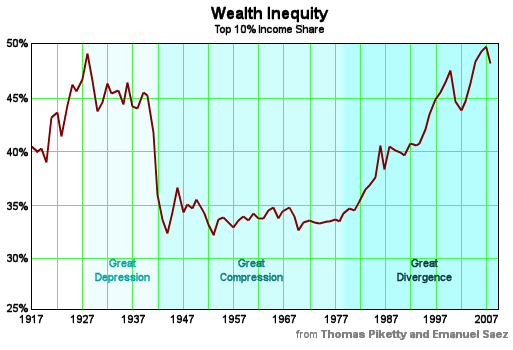
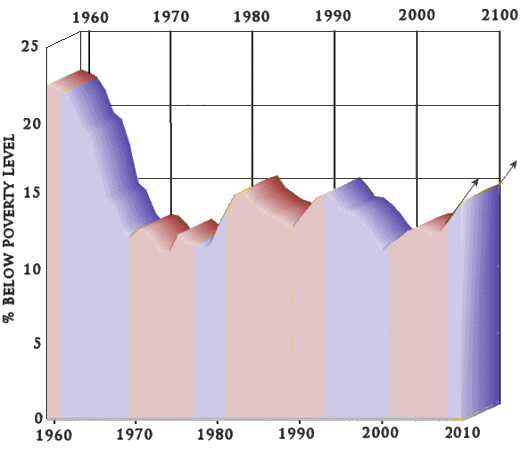
Sorry, the comment form is closed at this time.